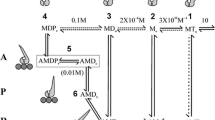Summary
Single glycerol-extracted rabbit psoas muscle fibres have been slowly extended either in rigor or in the unhydrolysable ATP analogue AMPPNP, and their sarcomere length, sarcomere structure and tension measured. The length of regularly arrayed sarcomeres, measured by optical diffraction, increased continuously as the muscle was stretched; the maximum sarcomere extension seen was approximately 6%. In the electron microscope sarcomeres from extended muscle fixed in rigor or AMPPNP remained regular in their internal structure, without rupture or obvious lengthening around the Z line. During steady extension at 0.024% per min the tension in the muscle fibre rose until it reached a limiting value [T m ] when the sarcomeres had stretched by 0.8–1.6% and then remained constant with continued extension, while the sarcomeres continued to stretch. Provided that a novel form of preparation of the glycerol-extracted fibres was employed,T m in rigor was a large fraction of the tension expected from an active isometric muscle fibre. In the presence of AMPPNPT m was reduced by a factor of 2 to 3. Step extension by 0.08% at 5-min intervals gave the same pattern of mechanical response with similar values ofT m . The isometric tension decay in the interval between the steps was very rapid at first and slowed continuously until the next step. The average speed of tension fall between 30 and 300 s after stretch was measured at each step and plotted relative to the tension in the muscle. The relationship approached linearity, although with a significant upward curvature at high tension. The proportionality constant of the rate of tension fall to tension was 4.5×10−4 s−1 in rigor and 9×10−4 s−1 in AMPPNP. These values are less than the apparent dissociation rate constants for acto-subfragment-1 or acto-heavy meromyosin under similar conditions (Marston, 1982). These results indicate that interfilament slip does occur in rabbit skeletal muscle both in rigor and in AMPPNP, but that it is much slower that that predicted from the behaviour of the isolated proteins, as if the myosin heads interacted so as to obstruct their detachment.
Similar content being viewed by others
References
Abbott, R. H. (1973) The effects of fibre length and calcium ion concentration on the dynamic response of glycerol extracted insect fibrillar flight muscle.J. Physiol. 231, 195–208.
Anderson, M. L. &Schoenberg, M. (1987) Possible cooperativity in crossbridge detachment in muscle fibers having magnesium pyrophosphate at the active site.Biophys. J. 52, 1077–82.
Aubert, X. (1956)Le Couplage Energetique de la Contraction Musculaire. Brussels: Arscia.
Biosca, J. A., Greene, L. E. &Eisenberg, E. (1986) Binding of AMPPNP to rabbit skeletal myofibrils.Biophys. J. 49, 447a.
Dantzig, J. A., Trentham, D. R. &Goldman, Y. E. (1985) Mechanics of muscle contraction and relaxation in ɛ-ATP and caged ɛ-ATP.Biophys. J. 47, 25a.
Douzou, P. (1977)Cryobiochemistry. London: Academic Press.
Eastwood, A. B., Wood, D. S., Bock, K. L. &Sorenson, M. M. (1979) Chemically skilled mammalian skeletal muscle. 1. The structure of skinned rabbit psoas.Tissue and Cell 11, 533–56.
Eisenberg, E. &Hill, T. L. (1985) Muscle contraction and free energy transduction in biological systems.Science (NY) 227, 999–1006.
Goldman, Y. E. &Simmons, R. M. (1977) Active and rigor muscle stiffness.J. Physiol,269, 55–7P.
Herlihy, E., Hegarty, P. V. H. &Heffron, J. J. A. (1972) Ultrastructural evidence for positive extension in mouse muscle in rigor mortis.Life Sciences (Oxford II) 11, 743–751.
Huxley, H. E. (1969) The mechanism of muscular contraction.Science (NY) 164, 1356–66.
Julian, F. J., Moss, R. L. &Waller, G. S. (1981) Mechanical properties and myosin light chain composition of skinned muscle fibres from adult and new-born rabbits.J. Physiol. 311, 201–18.
Kuhn, H. J. (1978) Crossbridge slippage induced by the ATP analogue AMPPNP and stretch in glycerol-extracted fibrillar muscle fibres.Biophys. struct. Mech. 4, 159–68.
Marston, S. B. (1982) The rates of formation and dissociation of actin-myosin complexes.Biochem. J. 203, 453–60.
Mulvany, M. J. (1975) Mechanical properties of frog skeletal muscles in iodoacetic acid rigor.J. Physiol. 252, 319–34.
Reedy, M. C., Reedy, M. K. &Tregear, R. T. (1988). Two attached non-rigor crossbridge forms in insect flight muscle.J. Mol. Biol. 204, 357–83.
Schoenberg, M. &Eisenberg, E. (1985) Muscle crossbridge kinetics in rigor and in the presence of ATP analogues.Biophys. J. 48, 863–71.
Suzuki, S. &Sugi, H. (1983) Extensibility of the myo-filaments of vertebrate skeletal muscle as revealed by stretching rigor muscle fibres.J. Gen. Physiol. 81, 531–46.
Tozeren, A. &Schoenberg, M. (1986) The effect of crossbridge clustering and head-head competition on the mechanical response of skeletal muscle under equilibrium conditions.Biophys. J. 50, 875–84.
Tozeren, A. (1987) The influence of doubly attached crossbridges on the mechanical behaviour of skeletal muscle fibers under equilibrium conditions.Biophys. J. 52, 901–6.
Tregear, R. T. (1988) Mechanical properties of demem-branated muscle fibres in the presence of AMPPNP. InMolecular Mechanism of Muscle Contraction (edited bySugi, H. &Pollack, G.) pp. 513–526. New York: Plenum.
Yamamoto, T. &Herzig, J. W. (1978) Series elastic properties of skinned muscle fibres in contraction and rigor. Pflgers Arch.373, 21–4.
Yount, R. G., Babcock, D., Ballantyne, W. &Ojala, D. (1971) Adenyl imidodiphosphate, and adenosine triphosphate analog containing a P-N-P linkage.Biochemistry 10, 2484–9.
Author information
Authors and Affiliations
Rights and permissions
About this article
Cite this article
Somasundaram, B., Newport, A. & Tregear, R. Slip of rabbit striated muscle in rigor or AMPPNP. J Muscle Res Cell Motil 10, 360–368 (1989). https://doi.org/10.1007/BF01758432
Received:
Revised:
Issue Date:
DOI: https://doi.org/10.1007/BF01758432




